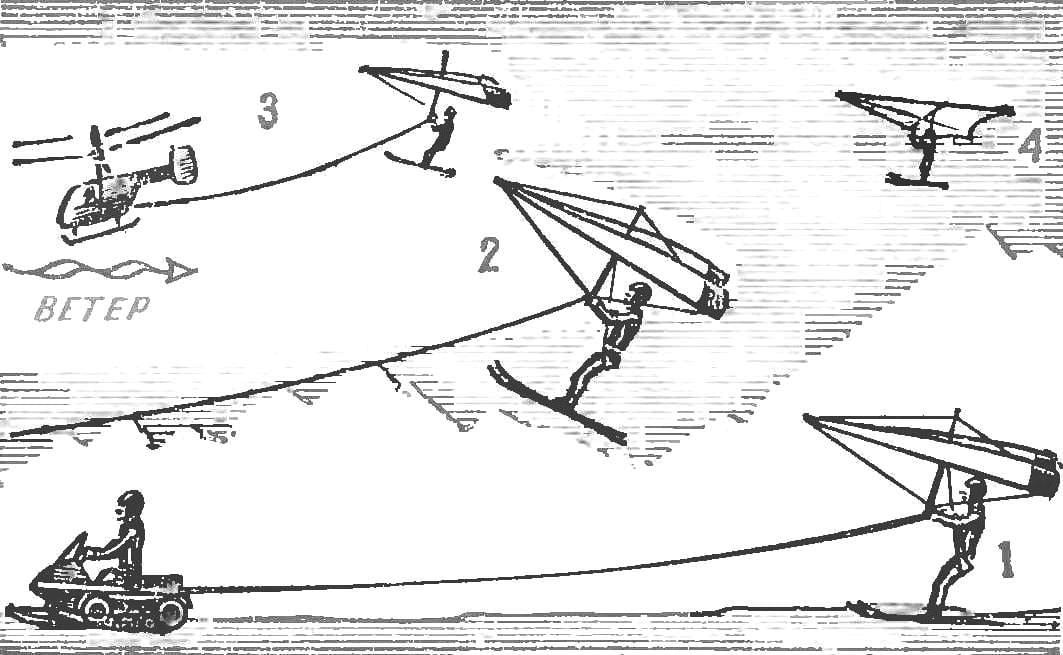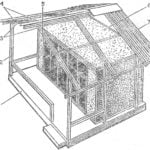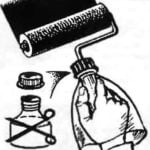 In the third issue of our journal in 1968 published a description of the design of snake-gibralta for water skiers, created by the pioneer of this sport in the USSR — Alexander Casein. Over the years the enthusiasts of technical creativity — IV first skiers — produced a large number of these aircraft. Flying snake-gibralta for the boat or car for many has become a favorite form of recreation. There had also been a successful winter flying in the mountains. Muscovite M. Gokhberg, master of sports of water skiing, winter 1973/74 year was flying on a kite, accelerating on the ski slopes in the area Terskol in the Caucasus.
In the third issue of our journal in 1968 published a description of the design of snake-gibralta for water skiers, created by the pioneer of this sport in the USSR — Alexander Casein. Over the years the enthusiasts of technical creativity — IV first skiers — produced a large number of these aircraft. Flying snake-gibralta for the boat or car for many has become a favorite form of recreation. There had also been a successful winter flying in the mountains. Muscovite M. Gokhberg, master of sports of water skiing, winter 1973/74 year was flying on a kite, accelerating on the ski slopes in the area Terskol in the Caucasus.
Today we introduce our readers with gibtelecom advanced type, which can be used, starting not only with water but with snow on a winter skiing, or even just running, if conditions permit areas (such flights are usually practiced in the area of sand dunes).
Foreign athletes will gibelet called “dragon”. He has been very widespread among skiers, which rise on it in air independently, speeding on the way down a smooth slope with a steepness of about 15-20° (Fig. 1) and with a winch or helicopter. Takeoff should be made strictly against the wind, otherwise the control gibtelecom difficult and there is a risk of tipping it in the air, the Second condition for flying off the slope — the presence of an open and quite spacious grounds at its base, necessary for planting.
Recently in the cinemas of our country was shown wide-screen color film titled “Happening in white”. It shows the flight of skiers towed to the snakes over the snow-covered peaks of the Alps — the spectacle is unforgettable and quite extraordinary. Unfortunately, the authors of the review did not explain how to perform such flights, and in the film, start the “Seleccion” is not shown.

Fig. 1. Flight of the “dragon” with the crackdown on skis:
1 — acceleration, angle of attack is minimal; 2 — takeoff the angle of attack increases the deviation of the forward trapezoid; 3 — free flight, the angle of attack is reduced and an optimal deviation trapezoid back; 4 — landing, the angle of attack increases vigorously deviation of a trapezoid forward to cushion the feet.

Fig. 2. Takeoff by mechanical traction:
1 — acceleration, angle of attack is minimal; 2 — takeoff the angle of attack increases the deviation of the trapezoid forward with a constant thrust, in flight on the tow angle is constant; 3 — flight in tow of the helicopter.
The uninitiated viewer the impression that they are flying on their own. In fact, the rise and the whole flight is made with the help of a helicopter at the speed of 55-60 km/h (Fig. 2). The possibility of uncoupling of the “dragon” from the tug of the tether, after which the skier can make free planning flight and landing at any convenient place. Some virtuosos manage to perform planning flights with spirals and reversals, and then sit exactly in the intended item at the sites of very limited size.
What differs the dragon from the serpent-gibralta design A. Kazennova? Primarily by the presence of a convenient seat bassinet with seat belts, so smallcheck absolutely not tired (remember that when flying on a kite A. Kazennova, the athlete hung on the hand that is not only tedious, but dangerous). Seat carrycot allows smilechicky a few to move right and left, forward and backward, which is required for management gibtelecom. Seat belts equipped with quick-release locks.
Unlike snake-gibralta A. Kazennova “dragon” does not have a rope bridle for attachment to the towing halyard.
It replaces the lock control lever which is located on the crossmember under the hand of the pilot. In form and principle of it is reminiscent of a motorcycle brake lever (or clutch) that are installed on the steering wheel. The presence of the castle gives smalltime greater freedom of action, allowing it to be disengaged from the towing unit at any time — for example, when you move to planning the descent or in the event of a critical situation (severe “buffeting” danger of collision, etc.).

Fig. 3. Basic dimensions of frame, planking and construction joints

Fig. 4. The design of the frame:
1 — front mount pipes and cables; 2 — lateral longitudinal tubes. 3 — mast (height 1000 mm); 4 — tender (turnbuckle) of the cable system; 5 —back top rope; b — Central pipe; 7— transverse tube; 8 — rear lower cables; 9 — rear attachment cables; 10 — upper front cable; 11—lateral cables; 12 — trapezium (width 650 mm, height 700 mm), letter B indicates the location of attachment of the towing lock; 13 — front lower cables; 14 — coupling lateral and transverse tubes; 15 — termination of the cable at the thimble; 16 — node cables to trapeze. The letter a shows the location of the suspension seat pilot.

Fig. 5. The evil and the details frame:
A — front mount pipes and cables; B — node connections of the side longitudinal tubes and cross member; The rear attachment point of the cables; — mount the mast and the longitudinal center of the pipe to the cross member; D — towing lock: 1 lever cutaway, 2 — base, 3 — ring tow rope (or tether), 4 — folding finger; E — suspension system pilot (blackboard — based 600X120X20 mm, pendant h belt made from parachute webbing).
The last feature of the “dragon” — a special cutting and sewing of the fabric, which is made of shell. This is done for greater flight safety: double seams like a wireframe grid, resilient to tear.
The frame of the “dragon” going from dural pipes grade D-16, with a wall thickness of 1.5 mm. the Diagram of the frame shown in figure 3, design — in figure 4, details in figure 5. The cables connecting the structure together, must be very carefully braided in shackles of appropriate diameter. Length of cables are selected so that when the circuit closing and wrapping the turnbuckles half they were slightly stretched (in flight, when filling the cladding air, slack in the lower cables is automatically selected).
The BASIC MATERIALS NECESSARY FOR the manufacture of SNAKE-GIBRALTA (Numbering corresponds to figure 4)
2, 6, 7 — dural tube Ø 45X115 (only 20 meters in length, see Fig. 3); 3, 12 — dural tube Ø 30X2; 5, 8, 10, 11, 13 — steel cable Ø 3 mm (25 meters); 4 — turnbuckles (screw couplers) length 200 mm; 1, 9, 14, 16 — sheet stainless steel with a thickness of 3-4 mm. cotton Fabric (depending on width) is about 35 meters.



